六年级下册第四单元整体教学设计
图片预览
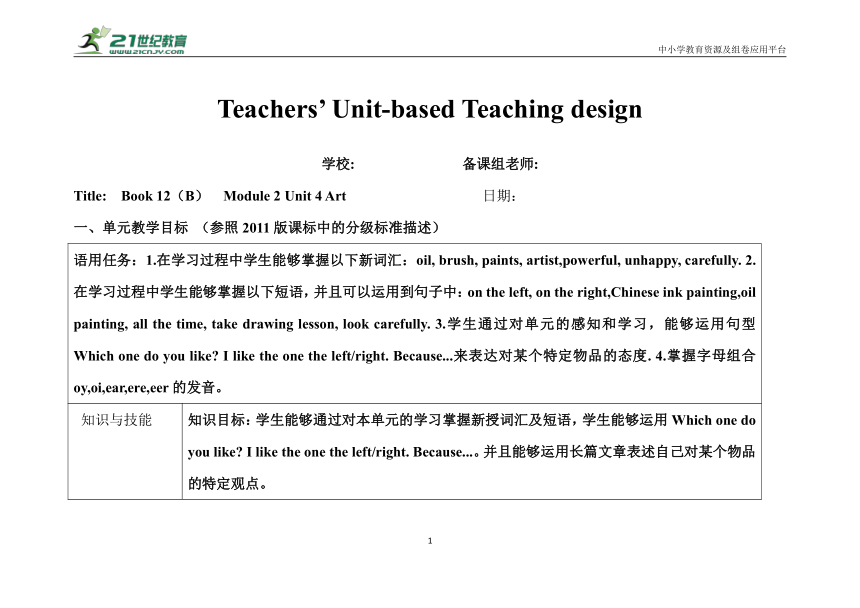
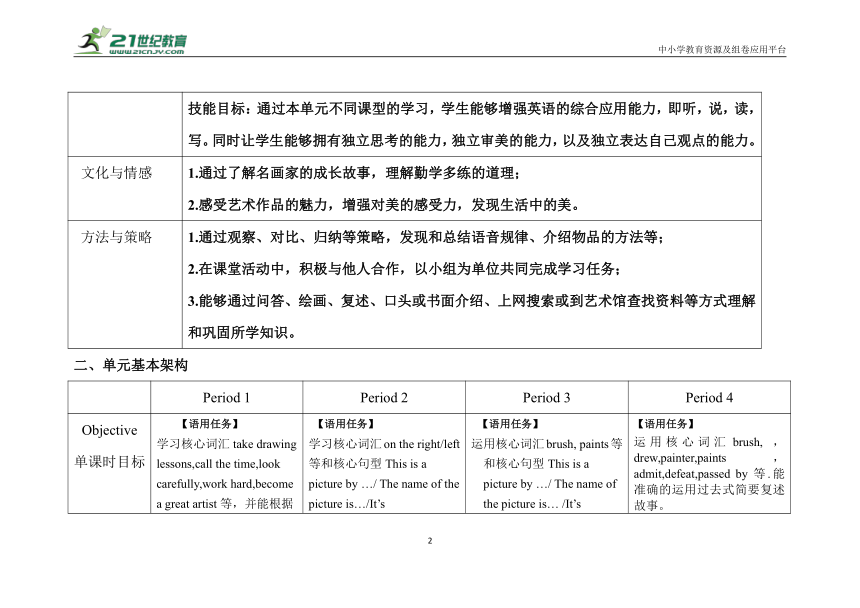
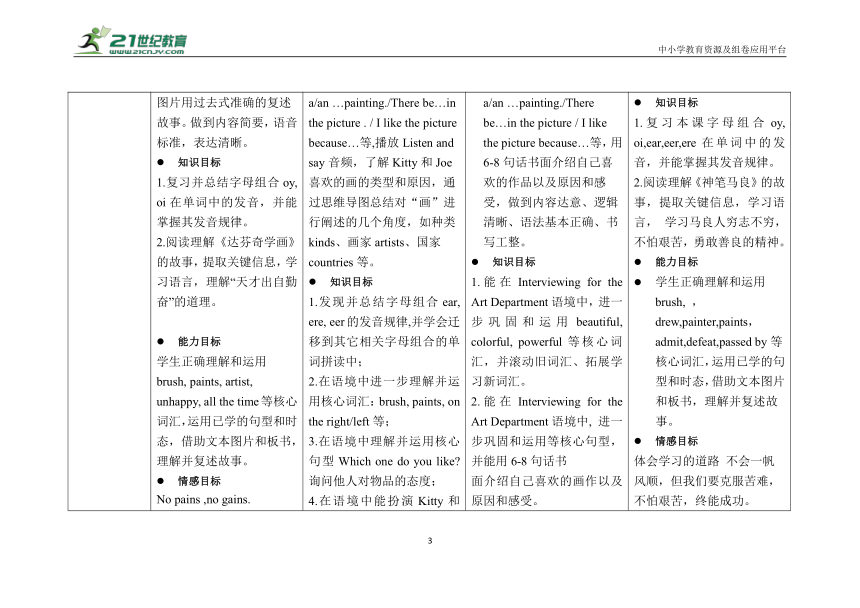
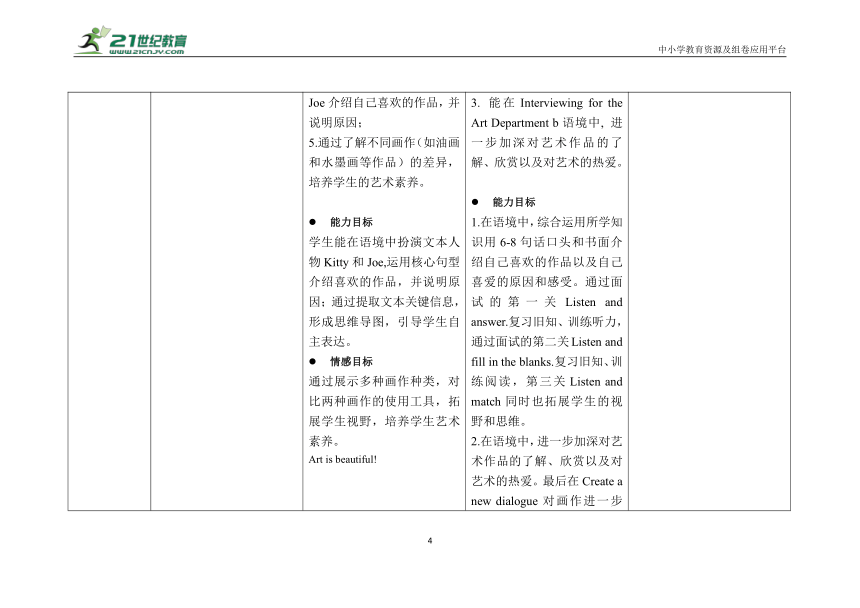
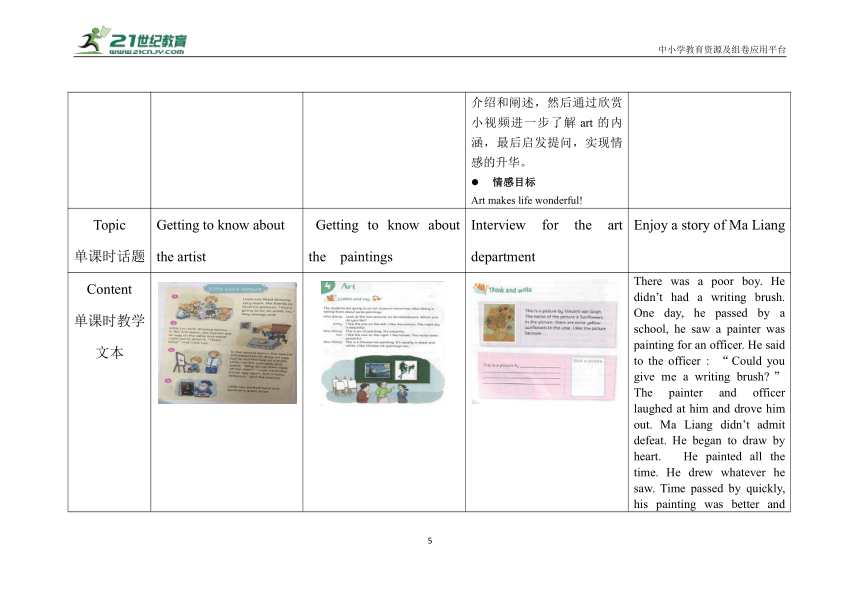
文档简介
中小学教育资源及组卷应用平台
Teachers’ Unit-based Teaching design
学校: 备课组老师:
Title: Book 12(B) Module 2 Unit 4 Art 日期:
一、单元教学目标 (参照2011版课标中的分级标准描述)
语用任务:1.在学习过程中学生能够掌握以下新词汇:oil, brush, paints, artist,powerful, unhappy, carefully. 2.在学习过程中学生能够掌握以下短语,并且可以运用到句子中:on the left, on the right,Chinese ink painting,oil painting, all the time, take drawing lesson, look carefully. 3.学生通过对单元的感知和学习,能够运用句型Which one do you like I like the one the left/right. Because...来表达对某个特定物品的态度. 4.掌握字母组合oy,oi,ear,ere,eer的发音。
知识与技能 知识目标:学生能够通过对本单元的学习掌握新授词汇及短语,学生能够运用Which one do you like I like the one the left/right. Because...。并且能够运用长篇文章表述自己对某个物品的特定观点。技能目标:通过本单元不同课型的学习,学生能够增强英语的综合应用能力,即听,说,读,写。同时让学生能够拥有独立思考的能力,独立审美的能力,以及独立表达自己观点的能力。
文化与情感 1.通过了解名画家的成长故事,理解勤学多练的道理;2.感受艺术作品的魅力,增强对美的感受力,发现生活中的美。
方法与策略 1.通过观察、对比、归纳等策略,发现和总结语音规律、介绍物品的方法等;2.在课堂活动中,积极与他人合作,以小组为单位共同完成学习任务;3.能够通过问答、绘画、复述、口头或书面介绍、上网搜索或到艺术馆查找资料等方式理解和巩固所学知识。
二、单元基本架构
Period 1 Period 2 Period 3 Period 4
Objective单课时目标 【语用任务】学习核心词汇take drawing lessons,call the time,look carefully,work hard,become a great artist等,并能根据图片用过去式准确的复述故事。做到内容简要,语音标准,表达清晰。知识目标1.复习并总结字母组合oy, oi在单词中的发音,并能掌握其发音规律。2.阅读理解《达芬奇学画》的故事,提取关键信息,学习语言,理解“天才出自勤奋”的道理。能力目标学生正确理解和运用brush, paints, artist, unhappy, all the time等核心词汇,运用已学的句型和时态,借助文本图片和板书,理解并复述故事。情感目标No pains ,no gains. 【语用任务】学习核心词汇on the right/left等和核心句型This is a picture by …/ The name of the picture is…/It’s a/an …painting./There be…in the picture . / I like the picture because…等,播放Listen and say音频,了解Kitty和Joe喜欢的画的类型和原因,通过思维导图总结对“画”进行阐述的几个角度,如种类kinds、画家artists、国家countries等。知识目标1.发现并总结字母组合ear, ere, eer的发音规律,并学会迁移到其它相关字母组合的单词拼读中;2.在语境中进一步理解并运用核心词汇:brush, paints, on the right/left等;3.在语境中理解并运用核心句型Which one do you like 询问他人对物品的态度;4.在语境中能扮演Kitty和Joe介绍自己喜欢的作品,并说明原因;5.通过了解不同画作(如油画和水墨画等作品)的差异,培养学生的艺术素养。能力目标学生能在语境中扮演文本人物Kitty和Joe,运用核心句型介绍喜欢的作品,并说明原因;通过提取文本关键信息,形成思维导图,引导学生自主表达。情感目标通过展示多种画作种类,对比两种画作的使用工具,拓展学生视野,培养学生艺术素养。Art is beautiful! 【语用任务】运用核心词汇brush, paints等和核心句型This is a picture by …/ The name of the picture is… /It’s a/an …painting./There be…in the picture / I like the picture because…等,用6-8句话书面介绍自己喜欢的作品以及原因和感受,做到内容达意、逻辑清晰、语法基本正确、书写工整。知识目标1.能在Interviewing for the Art Department语境中,进一步巩固和运用beautiful, colorful, powerful等核心词汇,并滚动旧词汇、拓展学习新词汇。2.能在Interviewing for the Art Department语境中, 进一步巩固和运用等核心句型,并能用6-8句话书面介绍自己喜欢的画作以及原因和感受。3. 能在Interviewing for the Art Department b语境中, 进一步加深对艺术作品的了解、欣赏以及对艺术的热爱。能力目标1.在语境中,综合运用所学知识用6-8句话口头和书面介绍自己喜欢的作品以及自己喜爱的原因和感受。通过面试的第一关Listen and answer.复习旧知、训练听力,通过面试的第二关Listen and fill in the blanks.复习旧知、训练阅读,第三关Listen and match同时也拓展学生的视野和思维。2.在语境中,进一步加深对艺术作品的了解、欣赏以及对艺术的热爱。最后在Create a new dialogue对画作进一步介绍和阐述,然后通过欣赏小视频进一步了解art的内涵,最后启发提问,实现情感的升华。情感目标Art makes life wonderful! 【语用任务】运用核心词汇brush, ,drew,painter,paints,admit,defeat,passed by等.能准确的运用过去式简要复述故事。知识目标1.复习本课字母组合oy, oi,ear,eer,ere在单词中的发音,并能掌握其发音规律。2.阅读理解《神笔马良》的故事,提取关键信息,学习语言, 学习马良人穷志不穷,不怕艰苦,勇敢善良的精神。能力目标学生正确理解和运用brush, ,drew,painter,paints,admit,defeat,passed by等核心词汇,运用已学的句型和时态,借助文本图片和板书,理解并复述故事。情感目标体会学习的道路 不会一帆风顺,但我们要克服苦难,不怕艰苦,终能成功。
Topic单课时话题 Getting to know about the artist Getting to know about the paintings Interview for the art department Enjoy a story of Ma Liang
Content单课时教学文本 There was a poor boy. He didn’t had a writing brush. One day, he passed by a school, he saw a painter was painting for an officer. He said to the officer : “Could you give me a writing brush ” The painter and officer laughed at him and drove him out. Ma Liang didn’t admit defeat. He began to draw by heart. He painted all the time. He drew whatever he saw. Time passed by quickly, his painting was better and better. One night in his dream, an old man gave him a writing brush. The old man told him to draw for poor people.Ma Liang drew a cock with the brush, and then the cock was alive. It was a magic writing brush. The officer heard that and catched Ma Liang. The officer asked Ma Liang to draw a gold mountain for him. Ma Liang drew a gold mountain and a sea . The officer also asked Ma Liang to draw a ship and wind , so he can got the gold mountain. Ma Liang drew a strong wind, and the officer died in the sea. Ma Liang went back to home and drew for poor people.
Blackboard design板书设计
三、单课教学设计
Period 1
Procedures Contents Methods Purpose
Pre-lesson 1.播放PPT中关于字母组合和儿歌的视频,让学生尝试自主朗读并总结其规律。 播放PPT视频音乐.2.学生朗读还有本课字母组合的顺口溜。 Learn the sounds通过诵读chant,复习旧知,复习oy, oi,字母组合发音,并总结其规律。
Pre-task preparation 2. 播放视频,引出学生要去参观Art Museum,并让学生了解参观Art Museum的三个准备:1) Getting to know about artists.2) Getting to know about paintings. 3)Interview for the Art Museum T: Today, Let’s get to know about some artists. 1.播放有关博物馆的视频,创设情境,学生们即将去博物馆参观,激发学生的学习兴趣。
While-task procedure 指导学生带着问题粗读文本,理解Artist 的含义。T:What does ARTIST mean 2. 再次引导学生感知文本1) 播放录音,呈现判断题。 ()Little Leo’s friends did not like his picture. ( ) Little Leo drew an egg in the first lesson. ( ) Little Leo drew an apple in the second lesson.2)提问学生,检查学生完成情况。在学生回答过程进行学法指导,引导学生关注文中关键信息。3)指导学生朗读和表演文中关键片段。 3. 出示问题,引导学生带着问题默读文本。 What did Leo always draw How many lessons did he take in the story What’s the similarities and differences of the first and second lesson 分段学习故事,引导学生回答第一、二个问题,并指导学生模仿录音的语音语调。2)指导学生讨论第三个问题。4.出示问题: T: What would happen in the third lesson?Can you guess how many days the teacher asked Leo to draw eggs? 建议:在分段学习时引导学生完成P25的填空, 小组合作表演。 快速阅读策略指导。培养学生提取关键信息的能力;二人小组合作进行;角色扮演3.读PPT上的问题,小组合作讨论What did Leo always draw How many lessons did he take in the story What’s the similarities and differences of the first and second lesson 4.完成25页剧本填空,并表演。 1. Read and choose 通过设疑,引导学生粗读文本,理解核心词汇Artist的含义。2. Listen and judge通过听文本做判断,引导学生再次感知文本细节,并了解Leo在两节课中分别画了什么物品,培养学生提取文中重要信息的能力。3. Read and answer细读文本,引导学生挖掘故事情感线索,进一步感悟文本。4.Think-pair-share小组合作完成25剧本表演,培养学生合作能力,考查学生文本输出。
Post-task activity 1.播放动画,复述故事并回答T: What can we learn from Leo 小 1.小组合作根据黑板图片复述故事,并总结 Leo ______we can learn from him. 1.Enjoy and say观看动画,让学生根据黑板图片复述故事,提升学生口语表达能力。同时思考What can we learn from Leo 启迪思维,总结出成为伟大的艺术家的条件,进一步启迪学生,实现情感升华。
Assignment 1. Read the story.
Period 2
Procedures Contents Methods Purpose
Pre-lesson 1. Greetings& Free talk2. Warming-up 英语口语交流 学生能够进入英语学习状态,活跃气氛,拉近师生距离。
Pre-task preparation Step1A.结合图片和伴奏进行chant;B.学习其他ear\ eer\ ere字母组合的单词;Step2:1)What can’t we do to interview for Ms. Xiao’s art club 2)Who is your favorite artist What did she/he paint 3) Look at this picture.The name of the picture is ___.It’s by __.In the painting, there is a ___ .I like it because… . 1.结合图片和伴奏进行chant,带通过单词deer,dear, here进行语音复习。2.通过思维导图进行Brain-storm,讨论画家、作品、类型等的知识总结。 通过复习含有ear, ere, eer 字母组合的单词,总结[i ]的发音规则。巩固关于物品名称、作者、内容的核心句型,奠定后面知识的学习。
While-task procedure 1.Watch and learn.Watch the video and find out the answers to the question.What are the students to do ...2.Listen and learn.Listen the material and find out the answers.Which kind of painting does Kitty or Joe like Which kind is it ...3.Group work4.Pk-reading6. Mind-map:1) the differences between the oil painting & the Chinese ink painting2) the differences between the tools of the two kinds of paintings3) the famous artist of the two kinds of paintings 观看视频,找到问题的答案,并且讲授重点单词和重点短语听音频,找到问题的答案,同时再次学习文本小组合作完成每组的6人答卷小火车小组进行朗读PK,其他小组找茬有了上面的足够训练,小组讨论完成思维导图 动画感知文本更加形象。看文本图片、提问,猜测文本大意,激发学生学习兴趣。增强学生听英语的能力,能够抓住关键词。证实猜想,进一步感知文本。团队合作回归文本,更细致地整体感知。理解文本,抓取关键信息的能力。加强英语朗读能力,张开嘴进行表达!同时训练倾听能力,找错误!进一步对文本的理解输出!
Post-task activity 1.Comparison:Show many pictures and let the students to identify. The students need to say out the artists and the arts’ names.2.Pictures sales 画作推销,学生需要用重点句型对作品进行介绍然后售卖。 This is a painting by…/The name of it is… It is a/ an…/In the paining, there is(are)…I like it because…3.Show 可以展示书上Listen and say上的内容,也可以展示上面“画作售卖”的情景。 增强语用输出能力,加强本课重点句型的运用。更深入熟悉文本,同时为后面作文输出奠定基础。给孩子足够的空间去展示自己对这个话题的理解。 检查学生是否掌握文本,同时加固理解。通过画作推销的活动,培养学生的语用输出能力。添加上孩子的个人展示能力,增强学生英语学习的趣味性,锻炼学生的能力。
Assignment Read the passage on Page 26.Try to sell another great pictures.
Period 3
Procedures Contents Methods Purpose
Pre-lesson Sing a songGreetings& Free-talk Which kind of paintings do you like What characters do oil/ink paintings have 活跃气氛带领孩子对重点句型进行复习 学生能够进入英语学习状态复习,对前面的知识进行滚雪球。
Pre-task preparation 1.Creating the situation and background introductionThere will be an interview in Bao’an District Library. They need a person who knows a lot of knowledge about paintings and artists.TipsYou need to finish all the changes one by one. 情景设置“宝安图书馆需要招募一名很懂画和画家的人”的面试。闯关游戏介绍,其实也就是接受不同的挑战获胜后才能被选上。 延续情境,让整个单元的开展更加的完整。提前告知学生要做好听力、对图片的识别以及艺术常识的准备。
While-task procedure 1.Ask and answer。 播放一段音频,展示图片,问与答。 Which picture does Tom/Joe like Why What colors are there in the oil painting 2.Listen and fill in the blank.The name of the picture is______________.It is by _______________.In the picture, there is _________________.The colors in it are_______________.The artist likes_______________....3.Listen and match.In the UK, this is the _______. 第一关:老师播放音频,学生听录音后回答问题。第二关:播放另一段音频,然后学生填空。第三关:播放音频,学生完成连线。 对书本上P26的Ask and answer 进行学习,同时是巩固前面Listen and say还有故事的学习。通过听录音的形式完成文本填空,完成P26Sunflowers文段,同时增强学生听英语及抓关键词的能力。将书上以及常见的画和作品进行联系,为孩子输出进行铺垫。
Post-task activity 1.Create a new dialogue.In order to introduce every picture in the library, the interviewee needs to make a short speech for it.2.Moral education.Different pictures and artists have different creation emotions. We need to get known more about pictures. 第四关:用重点句型进行画作介绍创编。面试选上后,进行“荣耀宣言”。 增强学生的语用能力。增强学生的语用能力,也促进学生学习的积极性,增加英语学习的趣味性。情感渗透,增强文化意识,同时培养学生创编文段的兴趣。
Assignment Choose one picture and try to make a short speech.(P26)
Period 4
Procedures Contents Methods Purpose
Pre-lesson Sing a song. “A magic brush ”Phonics time.Just true or false. 播放视频,学生唱歌,初步了解关于Ma Liang 的故事。呈现PPT中的题目,然后判断对错。 学生能够进入英语学习状态,同时歌曲是与本节课的故事有关的内容,初步熟悉故事,激发学生的兴趣。复习并检测语音部分的学习情况。
Pre-task preparation 1. Look and sayEnjoy different kinds of paintings and review the famous artists2.Today we will know about a famous artist in China . Watch and answer:Who is he 播放之前学过的名画以及名画家。抛出问题“In China, there is a magic artist ,Who is he ”为故事学习做好铺垫 拓展本单元内容,让学生有兴趣了解中国著名的寓言故事“神笔马良”
While-task procedure 1.Watch and answerWhat does Ma Liang have Why is the brush magic 2.Read and judge( ) When the officer laughed at Ma Liang ,he didn’t draw anymore( ) The old man gave Ma Liang a magicbrush.( )Ma Liang only drew a gold mountain for the officer.( ) Ma Liang helped the officer. 3.Present some new words and the phrases.4.Fill the blanks and read in groups 让学生快速阅读文章,找出答案。小组合作,阅读故事后,讨论完成相应的问题。老师播放PPT,教授本课新单词。小组合作完成填空,并齐读再次熟悉课文。 培养学生快速阅读能力。增强学生自主学习的能力和小组合作的能力。 攻破新单词,为复述故事做准备。熟练文章,为复述故事做准备。
Post-task activity 1.Retell the story in groups.2.Moral education. 学生小组合作复述故事,并分享从这个故事学到的道理。 增强学生的语用能力,也促进学生学习的积极性,增加英语学习的趣味性。情感渗透, 教育学生学习不怕艰苦,克服困难,终能成功!
Assignment Tell this story to your friends or your parents.
注:5-6年级可按4课时编写。谢谢!
4、教学设计说明 (不少于800字)
本单元的主题是Art,主要考察学生对某件物品的特定观点。1-5年级学过很多描述物品以及表达自己观点的句型,比如喜欢的颜色,玩具,食物,衣服,季节等等。这单元其实是对之前的一个学过的词汇以及句型的复习。由于学生的特征对艺术并不是特别的了解,所以我们设定了整个教学情境就是学生去参观艺术博物馆,第一课时设置情境是参观艺术博物馆之前要先了解一些艺术家,于是就先让学生学习了著名的画家的达芬奇的故事,学生从中知道什么是艺术家,艺术家是怎样来学习创作的,学习艺术家身上坚持不懈的精神。第二课时延续了第一课的情境,学生们去到博物馆了欣赏这些著名的绘画作品,并通过学习书中的对两幅画作的介绍This is a picture by …/ The name of the picture is…/It’s a/an …painting./There be…in the picture . / I like the picture because…,知道要从哪一些方面去欣赏一幅画,介绍一幅画,以及喜欢或者不喜欢这幅画作的原因,最后通过拓展介绍不同绘画种类,让学生知道 各种不同绘画的区别,为后来的第三课时写作奠定基础。第三课时通过学生参观完艺术博物馆后,对艺术有一定了解,情景设置“宝安图书馆需要招募一名很懂画和画家的人”的面试,面试者必须闯关成功才能面试成功。通过面试的第一关Listen and answer.复习旧知、训练听力,通过面试的第二关Listen and fill in the blanks.复习旧知、训练阅读,第三关Listen and match同时也拓展学生的视野和思维。最后在Create a new dialogue对画作进一步介绍和阐述,然后通过欣赏小视频进一步了解art的内涵,最后启发提问,实现情感的升华。第四课时是对本单元的一个补充拓展,讲述了中国著名的故事“神笔马良”,文章既有趣又有教育意义,里面的词汇句型有很多与本单元相关,也是一种滚动复习旧知的方式,同时也是一个很好的情感教育补充。教育孩子们不论艺术还是学习都不是容易的事情,要有不怕困难的精神!
五、阅读素养评价
A: Read and match:
A B C D
( )1. This is a picture by Zhao Ji. He was a great artist. He drew some flowers in the picture. I like the picture because he both drew well and wrote well.
( )2. This is a picture by Monet. He was a great artist. In the picture, the sun is rising. I like the picture because it is quiet and colourful.
( )3. This is a picture by Van Gogh. He was a great artist. In this picture, the wind is blowing in the wheat field. I can even smell the wheat. I like the picture because I like oil paintings.
( )4. I like the picture because I like Qi Baishi’s paintings. They are lovely. There are two peaches in this picture. He drew when he was ninety-three. He was great.
ii. 阅读下列短文,从选项中选出最佳选项。
B
Which painting is called “China’s Mona Lisa” It ’s Riverside Scene at Qingming Festival(清明上河图).It was painted by Zhang Zeduan. He was an artist in the Northern Song Dynasty. It has been collected by the Palace Museum in Beijing as a national treasure(国宝). The painting tells us the daily life of people in Bianjing (today’s Kaifeng ,Henan province).
( ) 5. Riverside Scene at Qingming Festival is called “______”
A. Mona Lisa B. China’s Mona Lisa C. China’s painting
( ) 6. Who painted Riverside Scene at Qingming Festival
A. Xu Beihong B. Zhang Zeduan C. Qi Baishi
( ) 7. Riverside Scene at Qingming Festival is in______ now.
A. Big Ben B. The Louvre Museum C. the Palace Museum
( ) 8. Riverside Scene at Qingming Festival tells us people’s ______in Bianjing.
A. life B. ideas C. clothes
( ) 9. Bianjing is today’s______ ,it’s in Henan Province(省).
A. Luoyang B. Zhengzhou C. Kaifeng
C
Xu Beihong (July 19,1895-September 26,1953) was the most famous painter in China. He was born in Yixing, Jiangsu Province. Xu Beihong was a master of both oil and Chinese ink. Most of his works, however, were in the Chinese traditional style(传统风格). He studied in France to learn painting. After coming back to China, he used to teach at Peking University. He is good at figures(人物),animals, flowers and birds. He is especially famous for his painting –the Eight Horses in the world. Xu Beihong, Liu Zigu and Zhang Shuqi are called “Jinling Three” (金陵三杰)for their painting.
( )10. Xu Beihong’s birthday is in _______________.
A. July B. September C. June
( )11. He was born in _______.
A. Shenzhen B. Guangzhou C. Jiangsu
( ) 12. He learned painting in _________.
A. the UK B. the USA C. France
( )13. He is good at drawing _________.
A. flowers B. horses C. Both A and B
( )14. “Jinling Three” are the Liu Zigu , Zhang Shuqi and _________
A. Leo B. Xu Beihong C. Zhang Daqian
D
The sunflowers are the subject of a series of still life paintings executed in oil on canvas by the Dutch painter Vincent van Gogh. The petals are shiny golden like the sunshine. The stamens are as fire, or fire ball. Van Gogh pursues the expressive of lines and color use, stick and recklessly. The thick brush makes the picture like a sculpture. You can see the brilliant yellow color with the whole picture, causing the people of great spiritual exciting.
Van Gogh began painting the sunflowers which have been duplicated many times by various artists
and displayed everywhere in late summer 1888 and continued into the following year in France.
The paintings show sunflowers in all stages of life, from fully in bloom to withering. The paintings
were innovative for their use of the yellow spectrum, partly because newly invented pigments
made new colours possible. In a letter to his brother Theo, van Gogh wrote: the sunflower is mine
in a way. In short, His sunflower is not only a plant, but the living organism with enthusiasm and
primitive impulse, twinkling like the burning flame. The sunflower in Van Gogh’s paintings
represents ideas of the sun and hope. Though one has ups and downs to face down the road, his love
for life is hard to fade away. That the golden color of the sunshine keeps popping up before my eyes
is an indication that van Gogh's "Sunflowers" speaks for what I have been unable to bring out from my heart.
阅读答案
A ( 1. A 2.D 3 .B 4. C)
B (1. B 2.B 3.C 4. A 5 C)
C (1. A 2.C 3.C 4. C 5 B)
D 美文欣赏,无须答题
六、课外阅读拓展
1. 推荐活动:参观何香凝美术馆、关山月美术馆等相关场所,欣赏中外名画。
2. 推荐相关主题电影:《达芬奇的密码》
22
Teachers’ Unit-based Teaching design
学校: 备课组老师:
Title: Book 12(B) Module 2 Unit 4 Art 日期:
一、单元教学目标 (参照2011版课标中的分级标准描述)
语用任务:1.在学习过程中学生能够掌握以下新词汇:oil, brush, paints, artist,powerful, unhappy, carefully. 2.在学习过程中学生能够掌握以下短语,并且可以运用到句子中:on the left, on the right,Chinese ink painting,oil painting, all the time, take drawing lesson, look carefully. 3.学生通过对单元的感知和学习,能够运用句型Which one do you like I like the one the left/right. Because...来表达对某个特定物品的态度. 4.掌握字母组合oy,oi,ear,ere,eer的发音。
知识与技能 知识目标:学生能够通过对本单元的学习掌握新授词汇及短语,学生能够运用Which one do you like I like the one the left/right. Because...。并且能够运用长篇文章表述自己对某个物品的特定观点。技能目标:通过本单元不同课型的学习,学生能够增强英语的综合应用能力,即听,说,读,写。同时让学生能够拥有独立思考的能力,独立审美的能力,以及独立表达自己观点的能力。
文化与情感 1.通过了解名画家的成长故事,理解勤学多练的道理;2.感受艺术作品的魅力,增强对美的感受力,发现生活中的美。
方法与策略 1.通过观察、对比、归纳等策略,发现和总结语音规律、介绍物品的方法等;2.在课堂活动中,积极与他人合作,以小组为单位共同完成学习任务;3.能够通过问答、绘画、复述、口头或书面介绍、上网搜索或到艺术馆查找资料等方式理解和巩固所学知识。
二、单元基本架构
Period 1 Period 2 Period 3 Period 4
Objective单课时目标 【语用任务】学习核心词汇take drawing lessons,call the time,look carefully,work hard,become a great artist等,并能根据图片用过去式准确的复述故事。做到内容简要,语音标准,表达清晰。知识目标1.复习并总结字母组合oy, oi在单词中的发音,并能掌握其发音规律。2.阅读理解《达芬奇学画》的故事,提取关键信息,学习语言,理解“天才出自勤奋”的道理。能力目标学生正确理解和运用brush, paints, artist, unhappy, all the time等核心词汇,运用已学的句型和时态,借助文本图片和板书,理解并复述故事。情感目标No pains ,no gains. 【语用任务】学习核心词汇on the right/left等和核心句型This is a picture by …/ The name of the picture is…/It’s a/an …painting./There be…in the picture . / I like the picture because…等,播放Listen and say音频,了解Kitty和Joe喜欢的画的类型和原因,通过思维导图总结对“画”进行阐述的几个角度,如种类kinds、画家artists、国家countries等。知识目标1.发现并总结字母组合ear, ere, eer的发音规律,并学会迁移到其它相关字母组合的单词拼读中;2.在语境中进一步理解并运用核心词汇:brush, paints, on the right/left等;3.在语境中理解并运用核心句型Which one do you like 询问他人对物品的态度;4.在语境中能扮演Kitty和Joe介绍自己喜欢的作品,并说明原因;5.通过了解不同画作(如油画和水墨画等作品)的差异,培养学生的艺术素养。能力目标学生能在语境中扮演文本人物Kitty和Joe,运用核心句型介绍喜欢的作品,并说明原因;通过提取文本关键信息,形成思维导图,引导学生自主表达。情感目标通过展示多种画作种类,对比两种画作的使用工具,拓展学生视野,培养学生艺术素养。Art is beautiful! 【语用任务】运用核心词汇brush, paints等和核心句型This is a picture by …/ The name of the picture is… /It’s a/an …painting./There be…in the picture / I like the picture because…等,用6-8句话书面介绍自己喜欢的作品以及原因和感受,做到内容达意、逻辑清晰、语法基本正确、书写工整。知识目标1.能在Interviewing for the Art Department语境中,进一步巩固和运用beautiful, colorful, powerful等核心词汇,并滚动旧词汇、拓展学习新词汇。2.能在Interviewing for the Art Department语境中, 进一步巩固和运用等核心句型,并能用6-8句话书面介绍自己喜欢的画作以及原因和感受。3. 能在Interviewing for the Art Department b语境中, 进一步加深对艺术作品的了解、欣赏以及对艺术的热爱。能力目标1.在语境中,综合运用所学知识用6-8句话口头和书面介绍自己喜欢的作品以及自己喜爱的原因和感受。通过面试的第一关Listen and answer.复习旧知、训练听力,通过面试的第二关Listen and fill in the blanks.复习旧知、训练阅读,第三关Listen and match同时也拓展学生的视野和思维。2.在语境中,进一步加深对艺术作品的了解、欣赏以及对艺术的热爱。最后在Create a new dialogue对画作进一步介绍和阐述,然后通过欣赏小视频进一步了解art的内涵,最后启发提问,实现情感的升华。情感目标Art makes life wonderful! 【语用任务】运用核心词汇brush, ,drew,painter,paints,admit,defeat,passed by等.能准确的运用过去式简要复述故事。知识目标1.复习本课字母组合oy, oi,ear,eer,ere在单词中的发音,并能掌握其发音规律。2.阅读理解《神笔马良》的故事,提取关键信息,学习语言, 学习马良人穷志不穷,不怕艰苦,勇敢善良的精神。能力目标学生正确理解和运用brush, ,drew,painter,paints,admit,defeat,passed by等核心词汇,运用已学的句型和时态,借助文本图片和板书,理解并复述故事。情感目标体会学习的道路 不会一帆风顺,但我们要克服苦难,不怕艰苦,终能成功。
Topic单课时话题 Getting to know about the artist Getting to know about the paintings Interview for the art department Enjoy a story of Ma Liang
Content单课时教学文本 There was a poor boy. He didn’t had a writing brush. One day, he passed by a school, he saw a painter was painting for an officer. He said to the officer : “Could you give me a writing brush ” The painter and officer laughed at him and drove him out. Ma Liang didn’t admit defeat. He began to draw by heart. He painted all the time. He drew whatever he saw. Time passed by quickly, his painting was better and better. One night in his dream, an old man gave him a writing brush. The old man told him to draw for poor people.Ma Liang drew a cock with the brush, and then the cock was alive. It was a magic writing brush. The officer heard that and catched Ma Liang. The officer asked Ma Liang to draw a gold mountain for him. Ma Liang drew a gold mountain and a sea . The officer also asked Ma Liang to draw a ship and wind , so he can got the gold mountain. Ma Liang drew a strong wind, and the officer died in the sea. Ma Liang went back to home and drew for poor people.
Blackboard design板书设计
三、单课教学设计
Period 1
Procedures Contents Methods Purpose
Pre-lesson 1.播放PPT中关于字母组合和儿歌的视频,让学生尝试自主朗读并总结其规律。 播放PPT视频音乐.2.学生朗读还有本课字母组合的顺口溜。 Learn the sounds通过诵读chant,复习旧知,复习oy, oi,字母组合发音,并总结其规律。
Pre-task preparation 2. 播放视频,引出学生要去参观Art Museum,并让学生了解参观Art Museum的三个准备:1) Getting to know about artists.2) Getting to know about paintings. 3)Interview for the Art Museum T: Today, Let’s get to know about some artists. 1.播放有关博物馆的视频,创设情境,学生们即将去博物馆参观,激发学生的学习兴趣。
While-task procedure 指导学生带着问题粗读文本,理解Artist 的含义。T:What does ARTIST mean 2. 再次引导学生感知文本1) 播放录音,呈现判断题。 ()Little Leo’s friends did not like his picture. ( ) Little Leo drew an egg in the first lesson. ( ) Little Leo drew an apple in the second lesson.2)提问学生,检查学生完成情况。在学生回答过程进行学法指导,引导学生关注文中关键信息。3)指导学生朗读和表演文中关键片段。 3. 出示问题,引导学生带着问题默读文本。 What did Leo always draw How many lessons did he take in the story What’s the similarities and differences of the first and second lesson 分段学习故事,引导学生回答第一、二个问题,并指导学生模仿录音的语音语调。2)指导学生讨论第三个问题。4.出示问题: T: What would happen in the third lesson?Can you guess how many days the teacher asked Leo to draw eggs? 建议:在分段学习时引导学生完成P25的填空, 小组合作表演。 快速阅读策略指导。培养学生提取关键信息的能力;二人小组合作进行;角色扮演3.读PPT上的问题,小组合作讨论What did Leo always draw How many lessons did he take in the story What’s the similarities and differences of the first and second lesson 4.完成25页剧本填空,并表演。 1. Read and choose 通过设疑,引导学生粗读文本,理解核心词汇Artist的含义。2. Listen and judge通过听文本做判断,引导学生再次感知文本细节,并了解Leo在两节课中分别画了什么物品,培养学生提取文中重要信息的能力。3. Read and answer细读文本,引导学生挖掘故事情感线索,进一步感悟文本。4.Think-pair-share小组合作完成25剧本表演,培养学生合作能力,考查学生文本输出。
Post-task activity 1.播放动画,复述故事并回答T: What can we learn from Leo 小 1.小组合作根据黑板图片复述故事,并总结 Leo ______we can learn from him. 1.Enjoy and say观看动画,让学生根据黑板图片复述故事,提升学生口语表达能力。同时思考What can we learn from Leo 启迪思维,总结出成为伟大的艺术家的条件,进一步启迪学生,实现情感升华。
Assignment 1. Read the story.
Period 2
Procedures Contents Methods Purpose
Pre-lesson 1. Greetings& Free talk2. Warming-up 英语口语交流 学生能够进入英语学习状态,活跃气氛,拉近师生距离。
Pre-task preparation Step1A.结合图片和伴奏进行chant;B.学习其他ear\ eer\ ere字母组合的单词;Step2:1)What can’t we do to interview for Ms. Xiao’s art club 2)Who is your favorite artist What did she/he paint 3) Look at this picture.The name of the picture is ___.It’s by __.In the painting, there is a ___ .I like it because… . 1.结合图片和伴奏进行chant,带通过单词deer,dear, here进行语音复习。2.通过思维导图进行Brain-storm,讨论画家、作品、类型等的知识总结。 通过复习含有ear, ere, eer 字母组合的单词,总结[i ]的发音规则。巩固关于物品名称、作者、内容的核心句型,奠定后面知识的学习。
While-task procedure 1.Watch and learn.Watch the video and find out the answers to the question.What are the students to do ...2.Listen and learn.Listen the material and find out the answers.Which kind of painting does Kitty or Joe like Which kind is it ...3.Group work4.Pk-reading6. Mind-map:1) the differences between the oil painting & the Chinese ink painting2) the differences between the tools of the two kinds of paintings3) the famous artist of the two kinds of paintings 观看视频,找到问题的答案,并且讲授重点单词和重点短语听音频,找到问题的答案,同时再次学习文本小组合作完成每组的6人答卷小火车小组进行朗读PK,其他小组找茬有了上面的足够训练,小组讨论完成思维导图 动画感知文本更加形象。看文本图片、提问,猜测文本大意,激发学生学习兴趣。增强学生听英语的能力,能够抓住关键词。证实猜想,进一步感知文本。团队合作回归文本,更细致地整体感知。理解文本,抓取关键信息的能力。加强英语朗读能力,张开嘴进行表达!同时训练倾听能力,找错误!进一步对文本的理解输出!
Post-task activity 1.Comparison:Show many pictures and let the students to identify. The students need to say out the artists and the arts’ names.2.Pictures sales 画作推销,学生需要用重点句型对作品进行介绍然后售卖。 This is a painting by…/The name of it is… It is a/ an…/In the paining, there is(are)…I like it because…3.Show 可以展示书上Listen and say上的内容,也可以展示上面“画作售卖”的情景。 增强语用输出能力,加强本课重点句型的运用。更深入熟悉文本,同时为后面作文输出奠定基础。给孩子足够的空间去展示自己对这个话题的理解。 检查学生是否掌握文本,同时加固理解。通过画作推销的活动,培养学生的语用输出能力。添加上孩子的个人展示能力,增强学生英语学习的趣味性,锻炼学生的能力。
Assignment Read the passage on Page 26.Try to sell another great pictures.
Period 3
Procedures Contents Methods Purpose
Pre-lesson Sing a songGreetings& Free-talk Which kind of paintings do you like What characters do oil/ink paintings have 活跃气氛带领孩子对重点句型进行复习 学生能够进入英语学习状态复习,对前面的知识进行滚雪球。
Pre-task preparation 1.Creating the situation and background introductionThere will be an interview in Bao’an District Library. They need a person who knows a lot of knowledge about paintings and artists.TipsYou need to finish all the changes one by one. 情景设置“宝安图书馆需要招募一名很懂画和画家的人”的面试。闯关游戏介绍,其实也就是接受不同的挑战获胜后才能被选上。 延续情境,让整个单元的开展更加的完整。提前告知学生要做好听力、对图片的识别以及艺术常识的准备。
While-task procedure 1.Ask and answer。 播放一段音频,展示图片,问与答。 Which picture does Tom/Joe like Why What colors are there in the oil painting 2.Listen and fill in the blank.The name of the picture is______________.It is by _______________.In the picture, there is _________________.The colors in it are_______________.The artist likes_______________....3.Listen and match.In the UK, this is the _______. 第一关:老师播放音频,学生听录音后回答问题。第二关:播放另一段音频,然后学生填空。第三关:播放音频,学生完成连线。 对书本上P26的Ask and answer 进行学习,同时是巩固前面Listen and say还有故事的学习。通过听录音的形式完成文本填空,完成P26Sunflowers文段,同时增强学生听英语及抓关键词的能力。将书上以及常见的画和作品进行联系,为孩子输出进行铺垫。
Post-task activity 1.Create a new dialogue.In order to introduce every picture in the library, the interviewee needs to make a short speech for it.2.Moral education.Different pictures and artists have different creation emotions. We need to get known more about pictures. 第四关:用重点句型进行画作介绍创编。面试选上后,进行“荣耀宣言”。 增强学生的语用能力。增强学生的语用能力,也促进学生学习的积极性,增加英语学习的趣味性。情感渗透,增强文化意识,同时培养学生创编文段的兴趣。
Assignment Choose one picture and try to make a short speech.(P26)
Period 4
Procedures Contents Methods Purpose
Pre-lesson Sing a song. “A magic brush ”Phonics time.Just true or false. 播放视频,学生唱歌,初步了解关于Ma Liang 的故事。呈现PPT中的题目,然后判断对错。 学生能够进入英语学习状态,同时歌曲是与本节课的故事有关的内容,初步熟悉故事,激发学生的兴趣。复习并检测语音部分的学习情况。
Pre-task preparation 1. Look and sayEnjoy different kinds of paintings and review the famous artists2.Today we will know about a famous artist in China . Watch and answer:Who is he 播放之前学过的名画以及名画家。抛出问题“In China, there is a magic artist ,Who is he ”为故事学习做好铺垫 拓展本单元内容,让学生有兴趣了解中国著名的寓言故事“神笔马良”
While-task procedure 1.Watch and answerWhat does Ma Liang have Why is the brush magic 2.Read and judge( ) When the officer laughed at Ma Liang ,he didn’t draw anymore( ) The old man gave Ma Liang a magicbrush.( )Ma Liang only drew a gold mountain for the officer.( ) Ma Liang helped the officer. 3.Present some new words and the phrases.4.Fill the blanks and read in groups 让学生快速阅读文章,找出答案。小组合作,阅读故事后,讨论完成相应的问题。老师播放PPT,教授本课新单词。小组合作完成填空,并齐读再次熟悉课文。 培养学生快速阅读能力。增强学生自主学习的能力和小组合作的能力。 攻破新单词,为复述故事做准备。熟练文章,为复述故事做准备。
Post-task activity 1.Retell the story in groups.2.Moral education. 学生小组合作复述故事,并分享从这个故事学到的道理。 增强学生的语用能力,也促进学生学习的积极性,增加英语学习的趣味性。情感渗透, 教育学生学习不怕艰苦,克服困难,终能成功!
Assignment Tell this story to your friends or your parents.
注:5-6年级可按4课时编写。谢谢!
4、教学设计说明 (不少于800字)
本单元的主题是Art,主要考察学生对某件物品的特定观点。1-5年级学过很多描述物品以及表达自己观点的句型,比如喜欢的颜色,玩具,食物,衣服,季节等等。这单元其实是对之前的一个学过的词汇以及句型的复习。由于学生的特征对艺术并不是特别的了解,所以我们设定了整个教学情境就是学生去参观艺术博物馆,第一课时设置情境是参观艺术博物馆之前要先了解一些艺术家,于是就先让学生学习了著名的画家的达芬奇的故事,学生从中知道什么是艺术家,艺术家是怎样来学习创作的,学习艺术家身上坚持不懈的精神。第二课时延续了第一课的情境,学生们去到博物馆了欣赏这些著名的绘画作品,并通过学习书中的对两幅画作的介绍This is a picture by …/ The name of the picture is…/It’s a/an …painting./There be…in the picture . / I like the picture because…,知道要从哪一些方面去欣赏一幅画,介绍一幅画,以及喜欢或者不喜欢这幅画作的原因,最后通过拓展介绍不同绘画种类,让学生知道 各种不同绘画的区别,为后来的第三课时写作奠定基础。第三课时通过学生参观完艺术博物馆后,对艺术有一定了解,情景设置“宝安图书馆需要招募一名很懂画和画家的人”的面试,面试者必须闯关成功才能面试成功。通过面试的第一关Listen and answer.复习旧知、训练听力,通过面试的第二关Listen and fill in the blanks.复习旧知、训练阅读,第三关Listen and match同时也拓展学生的视野和思维。最后在Create a new dialogue对画作进一步介绍和阐述,然后通过欣赏小视频进一步了解art的内涵,最后启发提问,实现情感的升华。第四课时是对本单元的一个补充拓展,讲述了中国著名的故事“神笔马良”,文章既有趣又有教育意义,里面的词汇句型有很多与本单元相关,也是一种滚动复习旧知的方式,同时也是一个很好的情感教育补充。教育孩子们不论艺术还是学习都不是容易的事情,要有不怕困难的精神!
五、阅读素养评价
A: Read and match:
A B C D
( )1. This is a picture by Zhao Ji. He was a great artist. He drew some flowers in the picture. I like the picture because he both drew well and wrote well.
( )2. This is a picture by Monet. He was a great artist. In the picture, the sun is rising. I like the picture because it is quiet and colourful.
( )3. This is a picture by Van Gogh. He was a great artist. In this picture, the wind is blowing in the wheat field. I can even smell the wheat. I like the picture because I like oil paintings.
( )4. I like the picture because I like Qi Baishi’s paintings. They are lovely. There are two peaches in this picture. He drew when he was ninety-three. He was great.
ii. 阅读下列短文,从选项中选出最佳选项。
B
Which painting is called “China’s Mona Lisa” It ’s Riverside Scene at Qingming Festival(清明上河图).It was painted by Zhang Zeduan. He was an artist in the Northern Song Dynasty. It has been collected by the Palace Museum in Beijing as a national treasure(国宝). The painting tells us the daily life of people in Bianjing (today’s Kaifeng ,Henan province).
( ) 5. Riverside Scene at Qingming Festival is called “______”
A. Mona Lisa B. China’s Mona Lisa C. China’s painting
( ) 6. Who painted Riverside Scene at Qingming Festival
A. Xu Beihong B. Zhang Zeduan C. Qi Baishi
( ) 7. Riverside Scene at Qingming Festival is in______ now.
A. Big Ben B. The Louvre Museum C. the Palace Museum
( ) 8. Riverside Scene at Qingming Festival tells us people’s ______in Bianjing.
A. life B. ideas C. clothes
( ) 9. Bianjing is today’s______ ,it’s in Henan Province(省).
A. Luoyang B. Zhengzhou C. Kaifeng
C
Xu Beihong (July 19,1895-September 26,1953) was the most famous painter in China. He was born in Yixing, Jiangsu Province. Xu Beihong was a master of both oil and Chinese ink. Most of his works, however, were in the Chinese traditional style(传统风格). He studied in France to learn painting. After coming back to China, he used to teach at Peking University. He is good at figures(人物),animals, flowers and birds. He is especially famous for his painting –the Eight Horses in the world. Xu Beihong, Liu Zigu and Zhang Shuqi are called “Jinling Three” (金陵三杰)for their painting.
( )10. Xu Beihong’s birthday is in _______________.
A. July B. September C. June
( )11. He was born in _______.
A. Shenzhen B. Guangzhou C. Jiangsu
( ) 12. He learned painting in _________.
A. the UK B. the USA C. France
( )13. He is good at drawing _________.
A. flowers B. horses C. Both A and B
( )14. “Jinling Three” are the Liu Zigu , Zhang Shuqi and _________
A. Leo B. Xu Beihong C. Zhang Daqian
D
The sunflowers are the subject of a series of still life paintings executed in oil on canvas by the Dutch painter Vincent van Gogh. The petals are shiny golden like the sunshine. The stamens are as fire, or fire ball. Van Gogh pursues the expressive of lines and color use, stick and recklessly. The thick brush makes the picture like a sculpture. You can see the brilliant yellow color with the whole picture, causing the people of great spiritual exciting.
Van Gogh began painting the sunflowers which have been duplicated many times by various artists
and displayed everywhere in late summer 1888 and continued into the following year in France.
The paintings show sunflowers in all stages of life, from fully in bloom to withering. The paintings
were innovative for their use of the yellow spectrum, partly because newly invented pigments
made new colours possible. In a letter to his brother Theo, van Gogh wrote: the sunflower is mine
in a way. In short, His sunflower is not only a plant, but the living organism with enthusiasm and
primitive impulse, twinkling like the burning flame. The sunflower in Van Gogh’s paintings
represents ideas of the sun and hope. Though one has ups and downs to face down the road, his love
for life is hard to fade away. That the golden color of the sunshine keeps popping up before my eyes
is an indication that van Gogh's "Sunflowers" speaks for what I have been unable to bring out from my heart.
阅读答案
A ( 1. A 2.D 3 .B 4. C)
B (1. B 2.B 3.C 4. A 5 C)
C (1. A 2.C 3.C 4. C 5 B)
D 美文欣赏,无须答题
六、课外阅读拓展
1. 推荐活动:参观何香凝美术馆、关山月美术馆等相关场所,欣赏中外名画。
2. 推荐相关主题电影:《达芬奇的密码》
22
同课章节目录
- Module 1 Changes and differences
- Unit 1 You and me
- Unit 2 Changes in our lives
- Unit 3 Our school in the future
- Project 1
- Module 2 Work and play
- Unit 4 Art
- Unit 5 Crafts
- Unit 6 PE lessons
- Project 2
- Module 3 Things we do
- Unit 7 Helping others
- Unit 8 Reading signs
- Unit 9 Reusing things
- Project 3
- Module 4 Things we enjoy
- Unit 10 Great storybooks
- Unit 11 Western festivals
- Unit 12 The five peas
- Project 4
